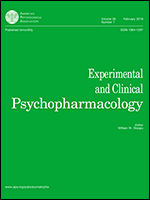
“Medications that improve pain threshold can be useful in the pharmacotherapy of Parkinson’s disease (PD). Pain is a prevalent PD’s non-motor symptom with a higher prevalence of analgesic drugs prescription for patients. However, specific therapy for PD-related pain are not available.
Since the endocannabinoid system is expressed extensively in different levels of pain pathway, drugs designed to target this system have promising therapeutic potential in the modulation of pain. Thus, we examined the effects of the 6-hydroxydopamine- induced PD on nociceptive responses of mice and the influence of cannabidiol (CBD) on 6-hydroxydopamine-induced nociception.
Further, we investigated the pathway involved in the analgesic effect of the CBD through the co-administration with a fatty acid amide hydrolase (FAAH) inhibitor, increasing the endogenous anandamide levels, and possible targets from anandamide, i.e., the cannabinoid receptors subtype 1 and 2 (CB1 and CB2) and the transient receptor potential vanilloid type 1 (TRPV1).
We report that 6-hydroxydopamine- induced parkinsonism decreases the thermal and mechanical nociceptive threshold, whereas CBD (acute and chronic treatment) reduces this hyperalgesia and allodynia evoked by 6-hydroxydopamine. Moreover, ineffective doses of either FAAH inhibitor or TRPV1 receptor antagonist potentialized the CBD-evoked antinociception while an inverse agonist of the CB1 and CB2 receptor prevented the antinociceptive effect of the CBD.
Altogether, these results indicate that CBD can be a useful drug to prevent the parkinsonism-induced nociceptive threshold reduction. They also suggest that CB1 and TRPV1 receptors are important for CBD-induced analgesia and that CBD could produce these analgesic effects increasing endogenous anandamide levels.”
https://www.ncbi.nlm.nih.gov/pubmed/31706993
“The CBD treatment decreases hyperalgesia and allodynia in experimental parkinsonism.”
https://www.sciencedirect.com/science/article/pii/S0028390819303703?via%3Dihub





 “Understanding how the body regulates pain is fundamental to develop rational strategies to combat the growing prevalence of chronic pain states, opioid dependency, and the increased financial burden to the medical care system.
“Understanding how the body regulates pain is fundamental to develop rational strategies to combat the growing prevalence of chronic pain states, opioid dependency, and the increased financial burden to the medical care system. “Muscle pain affects approximately 11-24% of the global population.
“Muscle pain affects approximately 11-24% of the global population.
 “Depression is a well-recognised effect of long-term treatment with interferon-alpha (IFN-α), a widely used treatment for chronic viral hepatitis and malignancy. In addition to the emotional disturbances, high incidences of painful symptoms such as headache and joint pain have also been reported following IFN-α treatment.
“Depression is a well-recognised effect of long-term treatment with interferon-alpha (IFN-α), a widely used treatment for chronic viral hepatitis and malignancy. In addition to the emotional disturbances, high incidences of painful symptoms such as headache and joint pain have also been reported following IFN-α treatment.

